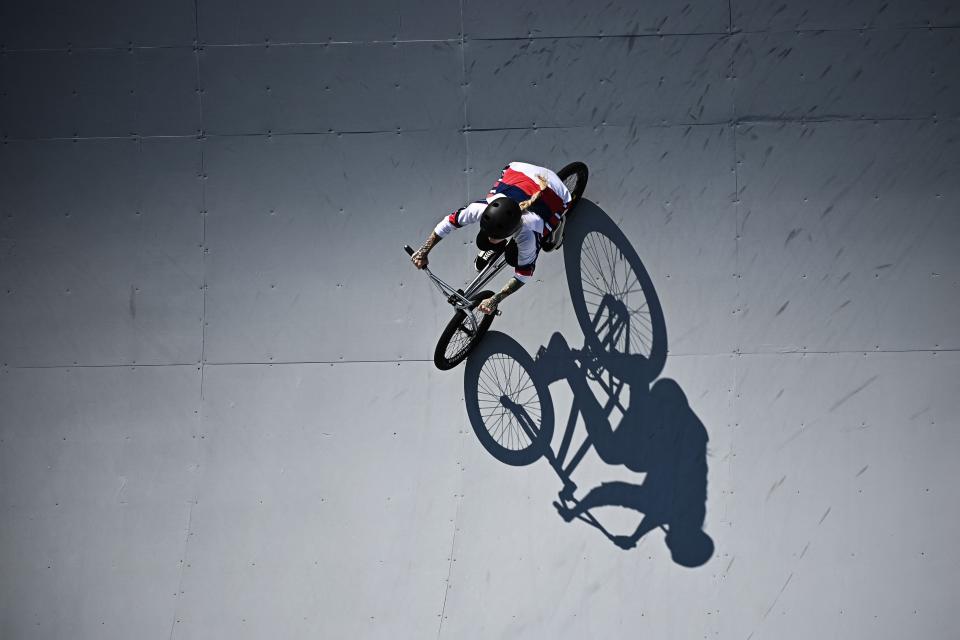Tokyo Olympics: Charlotte Worthington produces jaw-dropping ride for historic BMX freestyle gold
There was a moment when Charlotte Worthington was totally still, set on her bike, full weight on her pedals, chains taut, wheels stationary, looking at the big screen. Looking back at her was a list of the top three and what looked a winning score of 96.10 from USA’s Hannah Roberts.
Worthington had not watched Roberts’ run, and it was only when she was up on top of one of the ramps with “96.10” next to the American’s name that she realised how remarkable a ride it was and what she needed to pull out of the bag. “Geez, that’s a big score,” she said to herself. “Okay then.” Off she went down the first ramp, as Guns N Roses came through the speakers of the Ariake Sports Park, onto some fun and games that would write her into history as BMX freestyle’s first Olympic women’s champion.
The title was claimed, ultimately, with a jaw-dropping move early in an exemplary ride that even the 97.50 awarded does not do justice. Riders have two shots of 60 seconds to perform tricks and skills, judged on them across factors like difficulty, execution, height and originality, with the best of the two scores taken. For Worthington, an extra element to be commended on was recovery.
Her second trick in the sequence was an outlandish 360-backflip she botched in her first run. Despite her arm and confidence still feeling the impact of a battle lost to gravity, she took it on again, landed perfectly, becoming the first woman to pull off the manoeuvre in top-level competition.
That means a lot. Almost as much as the gold medal. Being the first to execute tricks in the heat of battle carries brings deep respect within the BMX community. Much like gymnastics where, for example, Simone Biles has four moves named after her, both fraternity and sorority will know Worthington was first.
The nature of freestyle means she had to keep quiet about the move in case others caught wind that she was cooking up something special. They may then work on that trick to cancel it out or concoct something of their own to better it.
BMX is no stranger to stealth and espionage. Ahead of London 2012, a member of Team USA rode the Olympic BMX race track armed with a mapping device, recording 3D images of the ramps and jumps and then using that information to build a replica in California to practice on. When the track was remodelled, they hired the builder who made the alterations and flew him over to amend their replica.
Even Saturday’s seeding event was a series of riders going through the motions, keeping their cards close to the chest. No one wanting to show their hand early, saving the elaborate, meet-winning moves for when they matter most.
Worthington has spent the last few months working in secret on the 360-backflip, initially on the resin practice ramps back in the United Kingdom, which are a bit more forgiving to joints and mistakes. It was only a couple of days ago here in Tokyo that she completed it on a wooden floor. Sunday’s safe landing was just the fourth this week.
“That was a big win, and it was really hard to keep that on the down-low,” she said, given such feats do great numbers when shared on social media. This breakthrough, however, was kept in the dark, in part because of the Games’ draconian rules around sharing footage during workouts. “I know that it wasn’t allowed to be posted because it’s in the Olympic practice,” she said, with a wry smile. “That was definitely an achievement in itself, so we were already winning for ourselves at the Olympics.”

Worthington was “a little bit giddy” for the first attempt, but was in no doubt that there was always going to be a second. She was conditioned to messing it up across the hours, days and weeks of trial and error. The podium was reachable with a score of 90 if she wanted to do without it. Sights, though, have been set a lot higher for a lot longer.
“It’s been gold medal or nothing this whole journey,” said Worthington, wearing that gold as she spoke. “It was ‘go big or go home’.” And big she went. Once the trick was nailed, she zoned out into the rest of what evolved into an unbeatable routine.
So big that Roberts, who had chucked her bike away after her first run – the BMX equivalent of the mic-drop – had to pick it up again. Just 20 seconds into her second effort, Roberts ceded defeat. Worthington had set the bar too high.
“I think more eyes are going to be on BMX, that’s for certain,” beamed Worthington of the knock-on effect of her achievement. If social media was anything to go by, there were plenty in the early hours of Sunday morning, cheering on her victory followed by a superb bronze from Declan Brooks in the men’s event.
Not just their respective friends and family. But countless others with no prior knowledge of the sport beyond the odd group of kids low-riding down their high streets. Or even those that frown at its inclusion in the Olympic Games. All utterly transfixed by these young men and women flipping themselves every which way, putting their bodies on the line for their rush and out entertainment. Gymnastics on bikes.
It caps a remarkable week for BMX, with four medals – one of every colour – in all available disciplines. Bethany Shriever’s gold in the women’s racing and Kye White’s silver in the men’s on Friday were sources of inspiration for Worthington and Brooks. “We got so emotionally invested in those guys,” said Brooks after the race.

The valuable offshoot of all this is not just that BMX is to be taken seriously by its audience, but also by the governing bodies. Shriever’s story of crowdfunding her way to Tokyo because UK Sport decided to only support male BMX riders after Rio is, frankly, shameful. And though there have been improvements to the system – Shriever has since rejoined British Cycling and there is a £3.6million investment through the cycling Places to Ride programme exclusively for BMX clubs and riders – pressure needs to be maintained when BMX disappears from our screens, back to its underground dwellings.
It is an event that ticks the box of legacy and ruthless competition. There is a meritocracy to its core and an urban heart that is as strong as it is open to all comers. A stark contrast to rowing which has underwhelmed spectacularly in Tokyo with just a silver and bronze off the back of £27million of funding. Perhaps a more certain return on that investment would be to row a few boats down the Thames to Embankment where they can be used as state-of-the-art ramps in the Southbank Skate Park where many a casual BMX rider tests their skills.
Worthington’s story is as heartening as it is cautionary. She has been working in the restaurant industry to feed her riding habit. Jobs have ranged from glass collection, waitressing, bar work, and, eventually, chef.
“I was working in the Racconto Lounge in Bury – then before that I was at the Beagle in Manchester, which was Mexican food,” she says, hoping her chef days are behind her. She attended a few events in 2018 and slowly began competing in them. Soon she discovered British Cycling was putting together an Olympic team.
“It kind of snowballed from there, I found out it was something I was really passionate about. I will never look back at the days of working in a kitchen.”
Giving herself to the sport was always a gamble. But, as she said of her second go of the twisting 360-backflip that is now synonymous with her name, “if you gamble and you give yourself that chance, it’s going to pay off better and going to feel better than if you hold off and think what could have been.”

She returns to Manchester with every long and short-term gamble paying off. BMX freestyle has its first female gold medalist, and Worthington global recognition that as a world leader in her craft.
BMX is likely to return most of the medals among the cycling squads of road and track. They are also likely to be the most inspiring regarding future interest and spurn a grassroots boost. Not just on excitement but on accessibility. As big as this Olympic stage is, and as serious as this competitive pursuit is, it remains a tight-knit community from top to bottom. Regardless of who took a medal this weekend, BMX was the winner.
“For the kids at home watching, you’ve just got to pick up a bike and have fun with it, because that’s what I did,” said Brooks, whose journey to this point began 15 years ago.
“If you want to come in this direction, great. If you don’t, it’s fine. Just have fun with your bike.”
Read More
Olympics 2021 schedule: A day-by-day guide to the Tokyo Games
Why is Russia banned from the Olympics and what is ROC?
Olympics skateboarding schedule: When will Sky Brown perform?

 Yahoo News
Yahoo News 
